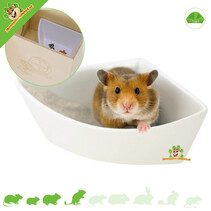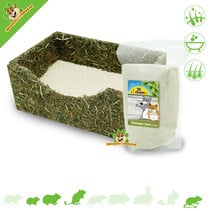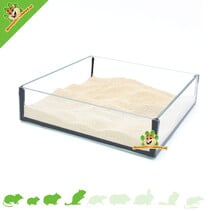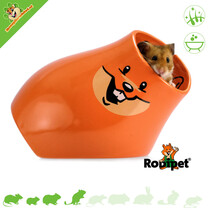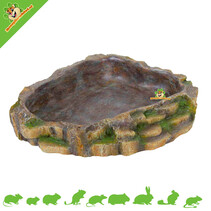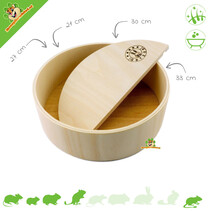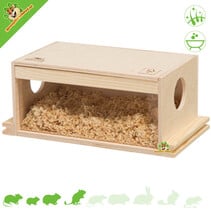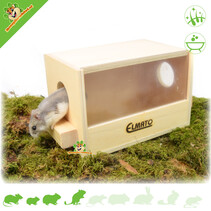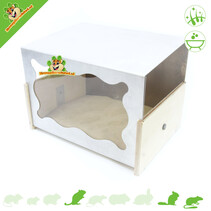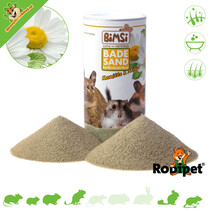Sand, Bath Sand & Sandboxes for Gerbils
- Ordered before 5 p.m., shipped the same day!
- Al 14 jaar een begrip!
- Delivery from our own stock
- Ordered before 5 p.m., shipped the same day!
- Al 14 jaar een begrip!
- Delivery from our own stock

You can easily and quickly order sand, bath sand & sandboxes at DRD Rodent Shop ® The Gerbil Webshop for your Gerbils!
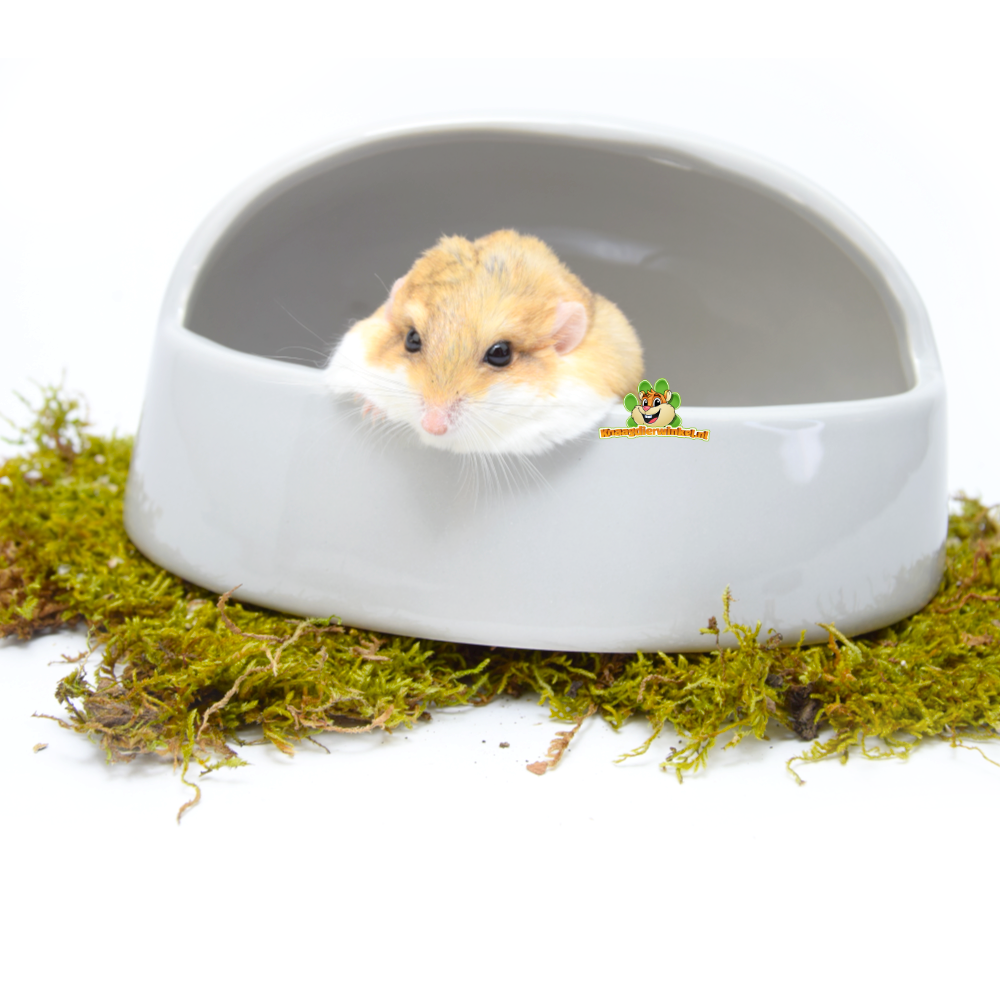 Gerbils are desert animals that like to dig in sand to make burrows and bathe to keep their fur clean. Gerbils need a sand bath daily to keep their skin and fur in good condition. Especially for Fat-tailed gerbils , a sandbox filled with bath sand is a must ! If there is no sand bath with chinchilla sand available, the gerbil's fur can quickly become greasy. As a result, the fur insulates less well and the gerbil can catch a cold.
Gerbils are desert animals that like to dig in sand to make burrows and bathe to keep their fur clean. Gerbils need a sand bath daily to keep their skin and fur in good condition. Especially for Fat-tailed gerbils , a sandbox filled with bath sand is a must ! If there is no sand bath with chinchilla sand available, the gerbil's fur can quickly become greasy. As a result, the fur insulates less well and the gerbil can catch a cold.
Why do gerbils need a sandbox?
Gerbils are desert animals that are naturally accustomed to dry, sandy habitats. A sandbox in their enclosure allows them to exhibit natural behaviors such as rolling, digging, and grooming. By rolling in the sand, gerbils naturally clean their fur, which helps remove grease and dirt. It also provides mental stimulation and prevents boredom.
Which sand is suitable for a gerbil sandbox?
We distinguish two types of sand for Gerbils: digging sand or bath sand. Chinchilla sand is suitable as bath sand. Other types of sand such as play sand do not care for the coat, so they do not have a caring function, only bath sand has this.
Popular choices include:
- Chinchilla sand
- Bath sand with herbs (such as lemon balm or chamomile)
- Desert sand (for a more natural look)
- Digging sand mixes for extra challenge
Attention! Never use shell sand in the sandbox. This sand is too sharp for the skin of the Gerbil.
What is the difference between digging sand, play sand and bath sand for Gerbils?
Digging sand is meant for digging. This sand is usually composed on a clay basis and ensures that dug tunnels remain standing. Play sand is cleaned sand in which the Gerbils can dig nicely, but the sand does not have a good structure and does not support the dug tunnels, so tunnels do not remain standing in play sand. Bath sand is meant as care for the animals. Gerbils cannot really dig in bath sand and certainly cannot make tunnels. The sand is very fine.
What is the best bath sand for Gerbils?
One of the best and natural types of sand for bathing is Sepiolite . Many good bath sands are made from Sepiolite. Especially the degreasing properties make this sand very suitable for the greasy coat of Gerbils.
Sepiolite is a mineral that belongs to the clay minerals. Sepiolite is often used as bath sand for hamsters and other rodents because it imitates the properties of their natural habitat. Sepiolite is a natural mineral that is formed by the deposition of clayey sediment. It has a fine, granular structure that resembles the soils in which hamsters dig and make tunnels in the wild. Thanks to the presence of this clay, the tunnels in the wild remain intact.
Sepiolite is usually obtained by mining techniques, whereby the sepiolite deposits are extracted from the ground. After extraction, these sepiolite deposits undergo a process of processing and purification. For example, sepiolite is also extracted from the desert in Syria ( original habitat of the Syrian Hamster ). Sepiolite is also mined in Mongolia. Mongolia has significant sepiolite reserves and is known for the presence of high-quality sepiolite deposits. The mineral is mainly mined in the southern regions of Mongolia ( original habitat of the Mongolian Gerbil )
Sepiolite has the ability to absorb moisture and fat, making it suitable as bath sand for rodents. It helps to clean the animal's fur and absorb excess oils. Sepiolite can also help to reduce odors.
How often should gerbils take a sand bath?
Daily! We recommend offering Gerbils a permanent sand bath in the enclosure. It is also possible to set up part of the enclosure as a sand section. In that case, part of the enclosure is fenced off and given chinchilla sand as bedding instead of standard gerbil bedding . The latter can be particularly useful for larger Gerbil groups and ensures that the entire group can bathe at the same time.
When should the Gerbil sand be changed?
We always say that as soon as it starts to smell, it needs to be replaced. As we have said, Gerbils are very clean animals that do not pee much. This ensures that the sandbox stays pretty clean in most cases. In most cases, the problem will be that the animals empty the sandbox rather than that it starts to smell. By the way, we have a handy trick for the poop! We have special sieve scoops with which the sand can be sieved and therefore lasts longer.
How big should a sandbox be for gerbils?
Gerbils love to roll, dig and jump, so the bigger the sandbox the better! A minimum diameter of around 20cm is recommended, but larger sandboxes such as 25 or 29cm will give more freedom of movement. Also make sure the sandbox is deep enough to accommodate a layer of at least 3 to 5cm of sand.
What material is best for a gerbil sandbox?
Sandboxes are available in different materials such as:
- Ceramic – sturdy, gnaw-resistant and stays cool
- Glass – hygienic, transparent and easy to clean
- Wood – natural and decorative, but less suitable for wet sand or heavy urine use
- Plastic – lightweight, but only choose safe, BPA-free varieties
For a durable sandbox that won't get knocked over, ceramic and glass are ideal.
Where do you place a sandbox in the enclosure?
Place the sandbox on a stable surface, preferably in a place where your gerbils like to hang out. A corner of the enclosure or under a platform often works well. Make sure the sand is not too close to the drinking water to prevent it from getting wet. Some sandboxes are even designed to fit in a corner or have a platform, which provides extra space.
Can you also use multiple sandboxes?
Definitely! Especially in a larger gerbil cage, it can be enriching to place sandboxes in different places. For example, you can use a larger box to roll in and a smaller corner box as a toilet. Some gerbils choose a fixed place to do their business, and a corner toilet with sand can be useful.
What is the difference between a sandbox and a digging bucket?
A sandbox usually contains fine bath sand and is used for cleaning the fur and performing rolling behavior. A digging box often contains a mixture of sand, humus and/or fibers, in which gerbils can actually dig tunnels. Both are important, but they fulfill a different purpose. Ideally, you offer your gerbils both!
Can a sandbox also serve as a toilet?
Yes, many gerbils instinctively choose a corner of the cage to do their business. If you place a corner sandbox or corner toilet with sand there, they can use that as a toilet. This makes cleaning a lot easier and helps keep the enclosure fresh for longer.
How do you clean a gerbil sandbox?
Ceramic, glass or plastic sandboxes can be easily cleaned with warm water. Avoid aggressive cleaning agents. For wooden sandboxes it is important to check whether puddles have ended up on the wood, if so a urine spray can provide a solution.
Can the sand be reused?
You can reuse the sand temporarily by sieving it regularly, but it will eventually need to be replaced. Sand that has become wet or has a strong odor should be replaced immediately. Do you want to make the sand last longer? Then use a fine sand sieve to easily remove feces and dirt.
Bonus Tips for the ideal gerbil sandbox:
- Add herbs for an extra experience (such as chamomile or lemon balm)
- Use a sandbox with a lid if you want to limit the spreading of sand
- Make it part of a hamster scaping setup with natural materials
- Choose a corner sandbox if space is limited





